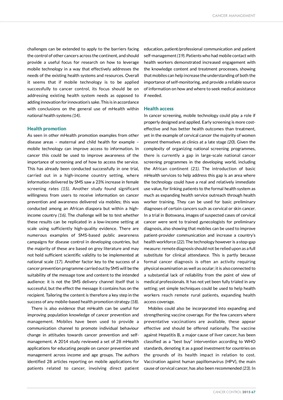
education, patient/professional communication and patient
self-management (19). Patients who had mobile contact with
health workers demonstrated increased engagement with
the knowledge content and treatment processes, showing
that mobiles can help increase the understanding of both the
importance of self-monitoring, and provide a reliable source
of information on how and where to seek medical assistance
if needed.
Health access
In cancer screening, mobile technology could play a role if
properly designed and applied. Early screening is more costeffective
and has better health outcomes than treatment,
yet in the example of cervical cancer the majority of women
present themselves at clinics at a late stage (20). Given the
complexity of organizing national screening programmes,
there is currently a gap in large-scale national cancer
screening programmes in the developing world, including
the African continent (21). The introduction of basic
mHealth services to help address this gap is an area where
the technology could have a real and relatively immediate
use value, for linking patients to the formal health system as
much as expanding health service outreach through health
worker training. They can be used for basic preliminary
diagnoses of certain cancers such as cervical or skin cancer.
In a trial in Botswana, images of suspected cases of cervical
cancer were sent to trained gynecologists for preliminary
diagnosis, also showing that mobiles can be used to improve
patient-provider communication and increase a country's
health workforce (22). The technology however is a stop-gap
measure: remote diagnosis should not be relied upon as a full
substitute for clinical attendance. This is partly because
formal cancer diagnosis is often an activity requiring
physical examination as well as ocular; it is also connected to
a substantial lack of reliability from the point of view of
medical professionals. It has not yet been fully trialed in any
setting; yet simple techniques could be used to help health
workers reach remote rural patients, expanding health
access coverage.
Mobiles could also be incorporated into expanding and
strengthening vaccine coverage. For the few cancers where
preventative vaccinations are available, these appear
effective and should be offered nationally. The vaccine
against Hepatitis B, a major cause of liver cancer, has been
classified as a "best buy" intervention according to WHO
standards, denoting it as a good investment for countries on
the grounds of its health impact in relation to cost.
Vaccination against human papillomavirus (HPV), the main
cause of cervical cancer, has also been recommended (23). In
CANCER MANAGEMENT
CANCER CONTROL 2015 67
challenges can be extended to apply to the barriers facing
the control of other cancers across the continent, and should
provide a useful focus for research on how to leverage
mobile technology in a way that effectively addresses the
needs of the existing health systems and resources. Overall
it seems that if mobile technology is to be applied
successfully to cancer control, its focus should be on
addressing existing health system needs as opposed to
adding innovation for innovation's sake. This is in accordance
with conclusions on the general use of mHealth within
national health systems (14).
Health promotion
As seen in other mHealth promotion examples from other
disease areas - maternal and child health for example -
mobile technology can improve access to information. In
cancer this could be used to improve awareness of the
importance of screening and of how to access the service.
This has already been conducted successfully in one trial,
carried out in a high-income country setting, where
information delivered by SMS saw a 23% increase in female
screening rates (15). Another study found significant
willingness from users to receive information on cancer
prevention and awareness delivered via mobiles; this was
conducted among an African diaspora but within a highincome
country (16). The challenge will be to test whether
these results can be replicated in a low-income setting at
scale using sufficiently high-quality evidence. There are
numerous examples of SMS-based public awareness
campaigns for disease control in developing countries, but
the majority of these are based on grey literature and may
not hold sufficient scientific validity to be implemented at
national scale (17). Another factor key to the success of a
cancer prevention programme carried out by SMS will be the
suitability of the message tone and content to the intended
audience: it is not the SMS delivery channel itself that is
successful, but the effect the message it contains has on the
recipient. Tailoring the content is therefore a key step in the
success of any mobile-based health promotion strategy (18).
There is also evidence that mHealth can be useful for
improving population knowledge of cancer prevention and
management. Mobiles have been used to provide a
communication channel to promote individual behaviour
change in attitudes towards cancer prevention and selfmanagement.
A 2014 study reviewed a set of 28 mHealth
applications for educating people on cancer prevention and
management across income and age groups. The authors
identified 28 articles reporting on mobile applications for
patients related to cancer, involving direct patient